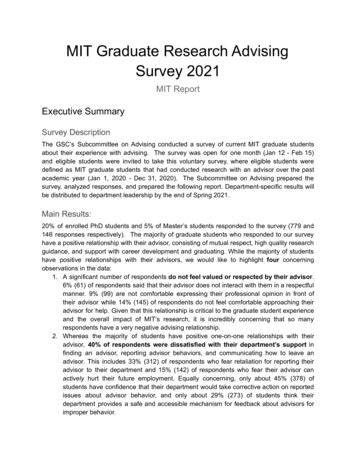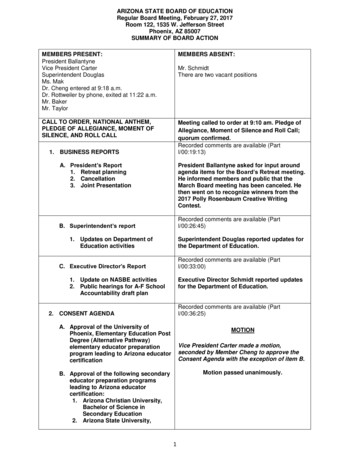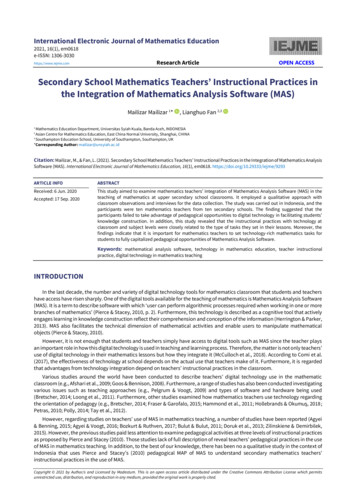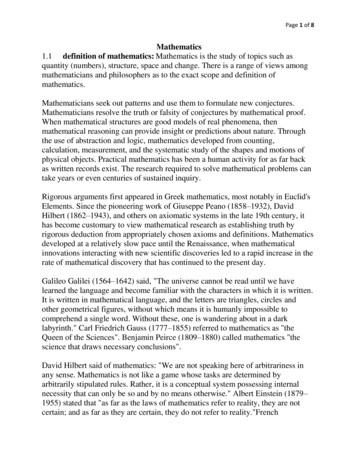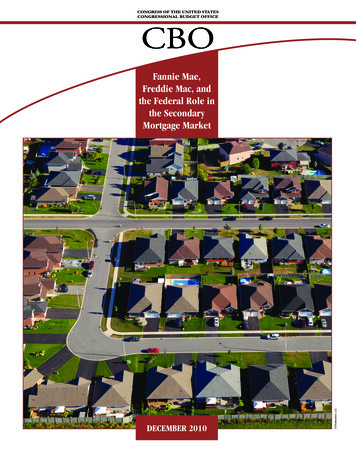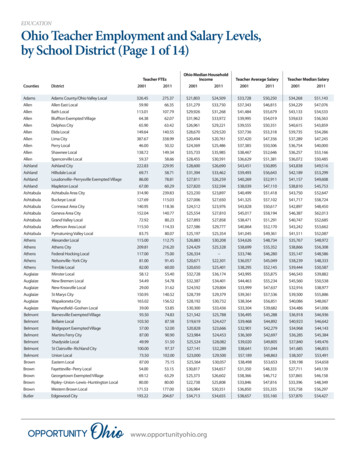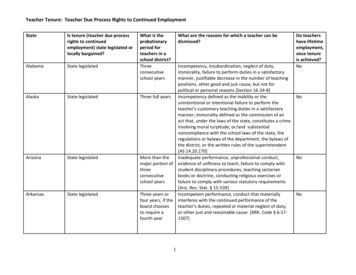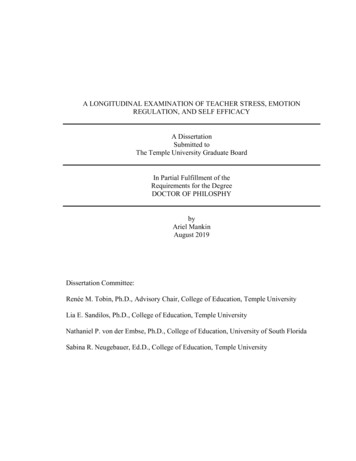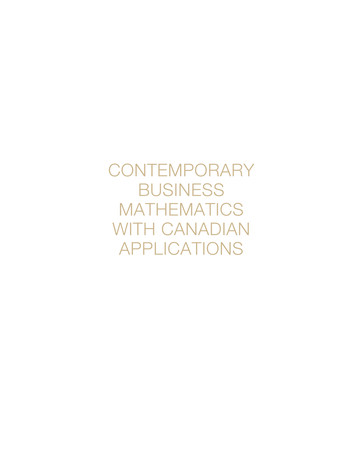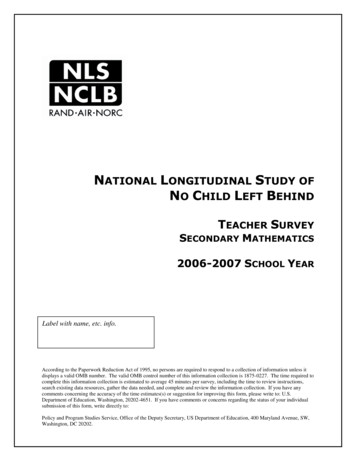
Transcription
NATIONAL LONGITUDINAL STUDY OFNO CHILD LEFT BEHINDTEACHER SURVEYSECONDARY MATHEMATICS2006-2007 SCHOOL YEARLabel with name, etc. info.According to the Paperwork Reduction Act of 1995, no persons are required to respond to a collection of information unless itdisplays a valid OMB number. The valid OMB control number of this information collection is 1875-0227. The time required tocomplete this information collection is estimated to average 45 minutes per survey, including the time to review instructions,search existing data resources, gather the data needed, and complete and review the information collection. If you have anycomments concerning the accuracy of the time estimates(s) or suggestion for improving this form, please write to: U.S.Department of Education, Washington, 20202-4651. If you have comments or concerns regarding the status of your individualsubmission of this form, write directly to:Policy and Program Studies Service, Office of the Deputy Secretary, US Department of Education, 400 Maryland Avenue, SW,Washington, DC 20202.
Dear Teacher,We are asking you to complete this survey as part of the National Longitudinal Study of NoChild Left Behind (NLS-NCLB). We greatly value the opinion of teachers and hope you willanswer this questionnaire: Purpose of Study: The survey asks about your experiences at your schooland about the professional development activities in which you engage. It isintended to learn about the implementation of No Child Left Behind (NCLB)in districts and schools. Sponsor: The study is being conducted by the RAND Corporation, theAmerican Institutes for Research (AIR), and the National Opinion ResearchCenter at the University of Chicago (NORC) and is sponsored by the U.S.Department of Education. Confidentiality: All information collected will be confidential. We will notprovide any information that identifies you or your school to anyone outsideof the study team, except as required by law. Response Burden: The survey will take approximately 45 minutes tocomplete. Benefits: Your participation will provide policy makers, educators andresearchers at the local, state, and national levels a more completeunderstanding of how schools are responding to the provisions of No ChildLeft Behind (NCLB). A 10 incentive is included with this questionnaire as atoken of our appreciation for your efforts. Voluntary participation: Taking part in this survey is voluntary. Yourrelationship to your school will not be affected if you decide not to completethe survey. More Information: For questions or more information about this study, youmay contact the NLS research team at nlsnclb@norc.org or call the study’stoll-free-number at 1-800-482-7149.Please write your answers directly on the questionnaire, by checking the appropriatebox, circling the appropriate number, or by writing your answer in the space given.Thank you for your cooperation in this very important effort!Teacher Survey – Secondary Mathematics2
Professional Background andCurrent Teaching AssignmentPlease be sure to answer questions only for the school where you received the survey. We willrefer to the school where you received this survey as “this school”.1)How do you classify your main teaching assignment at this school, that is, the activity atwhich you spend most of your time during the current school year (2006-07)? (Check onebox only.) Full-time teacher working only at this school2 Part-time teacher working only at this school3 Itinerant teacher (e.g., your assignment requires that you provide1instruction at more than one school)4 Long-term substitute (e.g., your assignment requires that you fill the roleof a regular teacher on a long-term basis, but you are still considered a substitute) Short-term substitute6 Student teacher or teacher intern7 Other staff (e.g., librarian, library media5(PLEASE DO NOT COMPLETE THIS SURVEY;please return it in the envelope provided)specialist, administrator, counselor,curriculum coordinator, secretary)82) OtherHow many years of teaching experience do you have: (Write in number of years. Count thecurrent year as one full year.)Number of yearsa.Teaching in totalyearsb.Teaching at this schoolyears3)In the current school year (2006-07), in what grades are the students that you teach inthis school? (Check all that apply.)Pre-K 1K 21 32 43 54 6Teacher Survey – Secondary Mathematics5 76 87 98 109 1110 1211 1312 14Ungraded 153
4)Which of the following describe the way your classes (or sections) are organized at thisschool? (Circle one number in each row.)Organization of ClassesNoYesa.Self-Contained Class: I teach the same group of students all or most of theday in multiple subjects12b.Departmentalized Instruction: I teach several classes of different studentsmost or all of the day in one or more subjects12c.“Pull-Out” Class: I teach selected students released from their regularclasses in specific skills or to address specific needs (e.g., gifted and talented,special education, reading, English as a second language)12Team Teaching: I am one of two or more teachers who are jointly responsiblefor teaching a single group of students12d.5)In the current school year (2006-07), what is your main teaching assignment at thisschool, that is, the field in which you teach the most classes? (Check one box only. If yourteaching time is equally divided among 2 or more fields, choose one.) Elementary grades, multiple subjects2 Special Education3 English/Language Arts/Reading4 Mathematics5 Science6 Social Sciences (History/Government/Civics/Geography)7 Foreign Languages8 Arts/Music9 English as a Second Language (ESL)/Bilingual Education10 Other16)How many separate classes (or sections) do you currently teach in the following subjectareas at this school? For example: If you teach 2 classes (or sections) of algebra I, aclass (or section) of geometry, and a class (or section) of calculus, you would report 4classes (or sections) for mathematics. (Write in number of classes or, if “0,” check “None” ineach row.)Subject AreaNumber ofclassesNonea.Mathematics classes (or sections) b.English/language arts/reading classes (or sections) c.Classes (or sections) in other subject areas Teacher Survey – Secondary Mathematics4
7)Of the academic classes that you teach at this school, how many classes (or sections)are classified in each of the following categories: (Write the number of classes or, if “0,”check “None” in each row.)Number ofclassesNonea.English as a second language (ESL) or English languagedevelopment class b.Sheltered content class for students with limited English proficiency-regular academic content delivered using basic English c.Non-sheltered content class-- regular class with students with limitedEnglish proficiency d.Bilingual class e.Class taught in student’s primary language (other than English) 8)At this school, what is the total number of students enrolled in all of the mathematicsclass(es) you taught during your most recent full week of teaching? (Write the number ofstudents.)(Total number of students)9)In this school, how many of the students you teach are considered: (Write the number ofstudents or check one box in each row.)Number ofstudentsNoneDon’t knowLow-achieving students (i.e., students who are atleast one year below state grade-level expectationsor who perform below proficiency on the stateassessment in one or more subjects) b.Students with individualized education programs(IEPs) c.Students with limited English proficiency (LEP) a.Teacher Survey – Secondary Mathematics5
Teacher QualificationsThe following set of questions asks about your current teacher qualification status (i.e. your“highly qualified teacher” status) under the provisions of No Child Left Behind (NCLB).10) Are you aware of your state’s requirements for you to be considered a “highly qualifiedteacher” under the provisions of No Child Left Behind (NCLB)? No, I am not aware of these requirements2 Yes, I am aware of these requirements1If yes, from whom did you learn of theserequirements? (Check all that apply.) From principal or administrator2 From another teacher3 From a professional development session4 From a college or university5 From media (television, website,1newspaper, etc.)6 From another source11) Have you been notified of your current teacher qualification status under NCLB? No, I have not been notified2 Yes, I have been notified112) According to the provisions of NCLB, are you currently considered “highly qualified” toteach: (Circle one number per row.)NoYesDon’t knowa.Mathematics123b.English/language arts/reading123c.Science123d.History, civics and government, economics, or geography123e.Foreign language123f.Arts12313) According to the provisions of NCLB, are you currently considered “highly qualified” forall of your current teaching assignments (i.e. for all the core academic subjects in whichyou currently teach a class)? (Check one box only.) No2 Yes3 Don’t know1GO TO QUESTION 15GO TO QUESTION 17Continue to next questionTeacher Survey – Secondary Mathematics6
14) Which of the following explains your “don’t know” response to the previous question?(Check all that apply.) 2 3 4 1No one has told me if I am considered “highly qualified” under NCLBMy “highly qualified” status is under appealI don’t know the specific requirements to be considered “highly qualified” under NCLBI am familiar with the requirements to be considered “highly qualified” butI don’t know if I meet them.IF YOU ANSWERED QUESTION 14, PLEASE GO TO QUESTION 18 ON PAGE 915) For what reason(s) are you not considered “highly qualified” for your current teachingassignments? (Check all that apply.) 2 3 4 5 1I do not hold a bachelor’s degreeI do not hold full certification or licensure in this stateI have not demonstrated subject matter competency in mathematicsI have not demonstrated subject matter competency in EnglishI have not demonstrated subject matter competency in anothersubject I teach (specify: )6 I am not considered “highly qualified” for other reason(s)(specify: )7 I don’t knowImportant Note – Answeringthat you do not have subjectmatter competency means thatyou: Do not have a major orcredits equivalent to amajor in the subject AND Do not have a graduatedegree in the subject AND Do not have advancedstate certification AND Have not passed a stateacademic subject test AND Have not met the highobjective uniform statestandard of evaluation(HOUSSE)16) In response to your current teacher qualification status under NCLB, what are you doingor what do you plan to do? (Check all that apply.) 2 3 4 5 Become certified or licensed in one or more of the core academic subjects you teach 7 8 9 Seek a change in teaching assignments (e.g., change subject or grades)1610 Earn a bachelor’s degreeEarn a master’s or doctorate degreeDemonstrate content expertise in a subject you teach by taking a state or other testDemonstrate content expertise in a subject you teach by completing additionalcourse work equivalent to a college majorSeek a change to another school (e.g., non-Title I school, private school)Leave the teaching profession (e.g., retire or change careers)Other (specify):None of the above-- I have not done and do not plan to do anything in responseto my status as not “highly qualified” under NCLB.IF YOU ANSWERED QUESTION 16, PLEASE GO TO QUESTION 18 ON PAGE 9Teacher Survey – Secondary Mathematics7
17) How did you demonstrate content knowledge in the subjects you teach, to be determined“highly qualified” under NCLB? (Check all that apply.) I passed a test in the subject(s) I teach (e.g., Praxis II)2 I completed a major (or equivalent) in the subject(s) I teach3 I completed a graduate degree in the subject(s) I teach4 I have advanced state certification or endorsements5 I demonstrated content knowledge in another way (e.g. HOUSSE)6 Don’t know1Teacher Survey – Secondary Mathematics8
Professional DevelopmentProfessional development refers to all activities intended to help teachers develop and improvetheir content knowledge and classroom instruction. Examples of professional developmentactivities include mentoring programs and coaching in addition to more traditional activities suchas internships, workshops, conferences, institutes, and college courses. These may beconducted within the school or outside the school setting.18) During the last school year (2005-06, including summer 2006), how many of the followingprofessional development activities did you participate in? (Mark one box in each row.)Professional Development ties11 or moreactivitiesa.Conferences lasting two days or longer b.Institutes (i.e., an intensive course of instructionon a particular topic or set of topics) lasting twodays or longer c.A series of connected workshops lasting two daysor longer d.Workshops lasting one day or lesse.Courses for college creditf.Internships 19) During the last school year (2005-06, including summer 2006), how many total hours didyou spend in the activities you described in question 18? (Write the number of hours.)(hours)20) Of the total hours of professional development you reported in question 19, how manydid you spend in each of the following areas: (Write the number of hours.)English/language arts/reading(hours)Mathematics(hours)Teacher Survey – Secondary Mathematics9
21) During the last school year (2005-06, including summer 2006), how frequently did youengage in each of the following professional development activities? (Circle one numberin each row.)Professional Development ActivitiesNeverOnce or afew times ayearOnce ortwice amonthOnce ortwice a weekDaily oralmost dailya.Planned lessons or courses with other teachers12345b.Consulted with other teachers about individualstudents (e.g., discussing specific students andarranging appropriate help)12345Exchanged feedback with other teachers based onclassroom observations (e.g., a teacher’sobservation of your class, your observation ofanother teacher’s class, or observation of a class viavideo)12345d.Exchanged feedback with other teachers based onstudent work12345e.Acted as a formal or informal coach or mentor toother teachers or staff12345f.Received formal or informal coaching or mentoringfrom other teachers or staff12345g.Was observed/evaluated by the school principal orother staff (e.g., department chair, master teacher)12345h.Participated in a learning community (e.g., teachercollaborative, network, or study group)12345i.Participated in a district or school committee focusedon curriculum, instruction, or student assessment12345j.Visited other schools to observe classroom teachingand learning12345c.22) During the last school year (2005-06, including summer 2006), how many total hours didyou spend in the activities you described in question 21? (Write the number of hours.)(hours)23) Of the total hours of professional development you reported in question 22, how manydid you spend in each of the following areas: (Write the number of hours.)English/language arts/reading(hours)Mathematics(hours)Teacher Survey – Secondary Mathematics10
24) During the last school year (2005-06, including summer 2006), about how many hours ofprofessional development did you receive in each of the following areas? (Consider allprofessional development activities you have reported thus far in questions 18-23. Mark onebox in each row.)Area of Professional rs41-80hoursMorethan 80hoursa.Instructional strategies for teachingmathematics b.In-depth study of topics in mathematics c.Instructional strategies for teachingEnglish/language arts/reading d.In-depth study of topics in English/languagearts/reading e.Instructional strategies or in-depth study oftopics in other academic subject (e.g.,science, social studies, foreign language, etc.) f.Instructional strategies for limited Englishproficient (LEP) students g.Instructional strategies for students withindividualized education programs (IEPs) h.Preparing students to take the annual stateassessment i.Analyzing and interpreting studentachievement data j.Classroom and behavior management k.Use of technology to improve classroominstruction l.Use of appropriate assessmentaccommodations Teacher Survey – Secondary Mathematics11
25) During the last school year (2005-06, including summer 2006), how much did theprofessional development in which you participated emphasize the followingmathematics topics? (Circle one number in each row.) I had no professional development in mathematicsTopicGO TO QUESTION 26Not isa.Number sense, properties, and relationships (e.g., place value,factors, order of operations, etc.)1234b.Operations (e.g., add and subtract, multiplication, division, etc.)1234c.Measurement (e.g., length, volume, time, etc.)1234d.Algebraic concepts (e.g., equations, functions, square roots, etc.)1234e.Geometric concepts (e.g., circles, polygons, symmetry, etc.)1234f.Probability and statistics (e.g., mean, median, mode, charts, graphs,etc.)1234g.Trigonometric concepts (e.g., cosines, identities, periodicity, etc.)1234h.Calculus concepts (e.g., limits, differentiation, integration, etc.)123426) Thinking of all the different professional development activities that you participated induring the last school year (2005-06, including summer 2006) and reported on in thissection (questions 18 to 25), approximately how many total hours did you spend inprofessional development? (Write in the number of hours.)(Total number of hours)27) Over all of your professional development activities during the last school year (2005-06,including summer 2006), how often did the following occur? (Circle one number in icipants observed demonstrations of teaching techniques1234b.Participants practiced what they learned and received feedback1234c.Participants led group discussions1234d.Participants conducted a demonstration of a lesson, unit or skill1234e.Participants developed and practiced using student materials1234f.Participants reviewed student work or scored assessments1234Teacher Survey – Secondary Mathematics12
28) During the last school year (2005-06, including summer 2006), how often did youparticipate in professional development activities in the following ways? (Circle onenumber in each row.)NeverRarelySometimesOftena.I participated in professional development activities together withmost or all of the teachers in my school1234b.I participated in professional development activities together withmost or all of the teachers in my department or grade level123429) During the last school year (2005-06, including summer 2006), how often were theprofessional development activities in which you participated: (Circle one number in eachrow.)NeverRarelySometimesOftena.Consistent with your own goals for your professional development1234b.Based explicitly on what you had learned in earlier professionaldevelopment experiences1234c.Designed to support state or district standards and/or assessments1234d.Designed as part of a school improvement plan to meet state,district, or school goals1234e.Designed to provide you with opportunities to discuss what youlearned with other teachers in your school or department who didnot attend the activity1234Designed to provide you with opportunities to communicate withparticipants in the activity who teach in other schools (outside offormal meetings held as part of the activity)1234f.30) How important was each of the following in determining which professional developmentactivities you participated in during the last school year (2005-06, including summer2006)? (Circle one number in each row.)Not at tremelyimportanta.District or school curricula1234b.NCLB requirements related to high quality professionaldevelopment or “highly qualified” teacher provisions1234c.State, district, or school requirements1234d.Principal or other school leader request or encouragement1234e.Your review of student test scores1234f.Other teacher’s recommendation1234g.Personal needs and/or interests1234Teacher Survey – Secondary Mathematics13
31) During the last school year (2005-06, including summer 2006), how useful were thefollowing professional development activities to you? (Circle one number in each row.)Professional Development ActivityDid notparticipate inactivities ofthis typeParticipatedbut did notlearn verymuchParticipatedand learned,but did notchange myteachingParticipated,learned, andchanged myteachinga.Conferences, institutes, or a series of connectedworkshops lasting two days or longer1234b.Workshops lasting one day or less1234c.Courses for college credit1234d.Planning lessons with other teachers1234e.Formal or informal coaching or mentoring1234f.Being observed/evaluated and receiving feedbackfrom the school principal or other staff (e.g.,department chair, master teacher)1234g.Visiting other classrooms or schools to observeclassroom teaching and learning1234h.Participating in a learning community (e.g., teachercollaborative, network, study group)1234i.Participating in on-line or web-based professionaldevelopment123432) During the last school year (2005-06, including summer 2006), how useful wereprofessional development activities focused on the following topics to you? (Include bothinformal learning activities listed in the above items as well as formal workshops and trainingsessions. Circle one number in each row.)Topic of Professional Development ActivityDid notparticipate inactivities onthis topicParticipatedbut did notlearn verymuchParticipatedand learned,but did notchange myteachingParticipated,learned, andchanged myteachinga.Mathematics1234b.English/language arts/reading1234c.Other academic subject (e.g., science, social studies,foreign language, etc.)1234d.Instructional strategies for limited English proficient(LEP) students1234e.Instructional strategies for students with individualizededucation programs (IEPs)1234f.Preparing students to take the annual stateassessment1234g.Analyzing and interpreting student achievement data1234h.Classroom and behavior management1234Teacher Survey – Secondary Mathematics14
33) Please indicate which of the following types of support you received during the lastschool year (2005-06, including summer 2006): (Circle one number in each row.)Type of SupportNoYesa.Release time for course preparation for the classes you teach (e.g., planningperiod)12b.Release time for taking college courses12c.Release time to work with other teachers (e.g., common planning time, teacherwork groups, teacher networks)12d.Program of sustained mentoring or induction for new teachers12e.Peer coaching12f.Funding for higher education courses (e.g., stipend for tuition)12g.Recruitment bonus12h.Retention bonus12i.Salary increase or bonus for reaching educational/professional goals12Teacher Survey – Secondary Mathematics15
School ImprovementThe following set of questions is related to improvement efforts that this school may or may notbe pursuing. As before, “this school” refers to the school where you received this survey.34) At this school, which of the following resources are available to help you align yourcurriculum and instruction with state content standards? (Circle one number in each row.)ResourcesNoYesDon’t knowa.District or school content standards that augment state contentstandards123b.Detailed curriculum guides, frameworks, and/or pacing sequences123c.Model lessons that are aligned with state content standards123d.A detailed table or report showing the alignment of required textbooksand instructional programs to state content standards123e.A detailed table or report showing the alignment of required textbooksand instructions programs to state assessments12335) How much of a challenge is each of the following to your efforts or this school’s effortsto improve student performance? (Circle one number in each row.)Type of ChallengeNot lengea.Large class size1234b.Inadequate or substandard facilities1234c.Too few textbooks and other instructional materials1234d.Textbooks and instructional materials that are not aligned with statestandards1234e.Poor student discipline1234f.Insufficient parent involvement1234g.Large number of student transfers into this school or your class atvarious points during the year1234h.Low student motivation1234i.Low staff morale1234j.Low and/or erratic student attendance1234Teacher Survey – Secondary Mathematics16
Accountability Targets and StatusAll states are required to have accountability systems that are consistent with No Child LeftBehind (NCLB). The following set of questions asks specifically about state-defined adequateyearly progress (AYP) performance targets and the identification of schools for improvementunder NCLB. They do not refer to separate state or district accountability systems that may alsobe used to evaluate school performance.36) Under No Child Left Behind (NCLB), schools have state-defined achievement targets fortheir students to make “adequate yearly progress” (AYP). Did this school meet itsoverall adequate yearly progress (AYP) target under NCLB based on test scores from thelast school year (2005-06)? (Check one box only.) No2 Yes3 Don’t know1Continue to next questionGO TO QUESTION 3837) Please indicate whether or not this school met each of the following AYP targets basedon 2005-06 test scores and other data: (Circle one number in each row.)AYP TargetsMet alltargetsMissed oneor moretargetsDon’tknowa.Mathematics proficiency targets123b.English/language arts/reading proficiency targets123c.Requirement that 95% of school’s students participate in testing123d.Other state indicator (e.g., attendance rate, graduation rate)12338) Is this school identified for improvement under NCLB for the current school year(2006-07)? (Check one box only.) No2 Yes3 Don’t know1Teacher Survey – Secondary Mathematics17
State AssessmentsThe questions in this section refer to “state tests” in mathematics. By “state tests” we mean theassessments used in your state for computing adequate yearly progress (AYP).39) During which month did you personally first see the results of the state test used forNCLB accountability in mathematics that were administered in 2005-06 in this school?(Check one box only.)1 Results have never been made available to me.2 Results were made available inGO TO QUESTION 42/ 2006(Month)40) Please indicate the availability and your use of the following types of data from the statetest in mathematics for this school: (Circle one number in each row.)Available and Have notreviewedHavereviewedbut did 3456Scale scores or other scores that showhow close students are to performancelevels123456Results for subgroups of students (e.g.,racial/ethnic subgroups, LEP students,students with disabilities, economicallydisadvantaged students)123456d.Results for each grade level123456e.Results for each classroom123456f.Results for individual students123456g.Results on specific math topics or skills(e.g., computation, applications, etc.)123456h.Changes or trends in test resultsacross years123456Notavailable inthis wayPercent of students at eachperformance level (basic, proficient,etc.)Type of dataa.b.c.Teacher Survey – Secondary Mathematics18
41) How much have you used the results from the 2005-06 state test in mathematics for eachof the following purposes? (Circle one number in each row.) I have not reviewed the mathematics resultsI used test results to GO TO QUESTION 42Did not usein this ntify individual students who need remedial assistance1234b.Tailor instruction to individual students’ needs1234c.Identify and correct gaps in the curriculum for all students1234d.Improve or increase the involvement of parents in studentlearning1234e.Recommend tutoring or other educational services tostudents or their parents1234f.Identify areas where I need to strengthen my contentknowledge or teaching skills1234g.Assign or reassign students to classes or groups1234h.Develop or revise individualized education programs (IEPs)1234Teacher Survey – Secondary Mathematics19
Progress TestsThe questions in this section refer to “progress tests” (also called “interim,” “benchmark,” or“diagnostic” tests) in mathematics. By “progress tests” we mean state, district or schoolrequired tests that are administered periodically (e.g., every 4-8 weeks) to monitor yourstudents’ progress in mathematics. “Progress tests” does NOT mean the annual STATEassessment in mathematics nor the tests that you develop or choose and administer on yourown in the classroom.42) Are you required by your district or this school to administer specific mathematicsprogress tests on a periodic basis (e.g., every 4-8 weeks) to monitor your students’progress? No2 Yes1GO TO QUESTION 46Continue to next question43) How often are the mathematics progress tests administered in this school? (Check onebox only.) Not administered at allGO TO QUESTION 462 Two to three times per year3 Approximately every six to eight weeks4 Monthly or more often144) Are the results from mathematics progress tests in this school available to you? No2 Yes1GO TO QUESTION 46Continue to next question45) How much have you used the results from mathematics progress tests for each of thefollowing purposes? (Circle one number in each row.)I used progress test results to Did not usein this ntify individual students who need remedial assistance1234b.Tailor instruction to individual students’ needs
Teacher Survey - Secondary Mathematics 6 Teacher Qualifications The following set of questions asks about your current teacher qualification status (i.e. your "highly qualified teacher" status) under the provisions of No Child Left Behind (NCLB). 10) Are you aware of your state's requirements for you to be considered a "highly qualified
